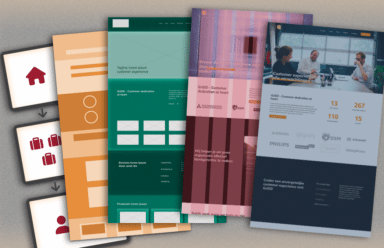
3 key differences between customer experience and marketing
This article was written by former GriDD member Fleur Elise Muller.
When it comes to terminology, marketing is all about the buzz. For example, think of terms such as customer experience, customer journey, branding, value proposition and UX design. In order to discover where your organization can still make a profit, it is very important to know what something entails and what it can mean for your organization.
In practice, we often see that marketing and customer experience are used interchangeably. While these terms have a lot of overlap, there are also major differences. To get you started, we’ll share the top three differences between customer experience (CX) and marketing!
The complete marketing process
Marketing is of course a very broad concept. It is a collective name for all tools, processes and activities that promote the sale of your services or products. In the image below you can see the phases that a customer goes through. This starts with awareness of a need (awareness) and continues to the purchase of a product (action) and binding your customer to your brand (loyalty). Marketing mainly focuses on stimulating sales, and thus on the awareness, consideration and action phases.

Influence on the customer experience
Customer experience can be seen as part of the marketing process, as described above. While marketing is mainly about things that drive sales, customer experience – you may have guessed it – is much more about the experience your customer has with your brand. Marketers can use customer experience to increase customer loyalty and thus offer an even better customer experience.
If we examine the added value of customer experience for marketers, you can say that the customer experience starts between the consideration and action phases. This is the moment when your customer consciously comes into contact with your brand. It is considered to choose your product or service and this choice is made in the action phase. The customer experience extends all the way to the advocacy and loyalty phase.
Why does the customer experience have an impact on these phases? Because your customer includes his or her experience with your brand in the selection process. And do you like it? Then there is a greater chance that the customer will remain loyal to your brand and will choose you again with a next purchase!
But what is the difference with the entire marketing process and how does it relate to each other? The following differences give you a clear picture of the dividing line between marketing and customer experience.
1. Sales versus emotion
As we mentioned, marketing is all about driving sales of your product or service. All tools, processes and activities that contribute to this fall under marketing. For example, think of a webshop, online advertisements, social media channels, good content and branding. These are not experiences yet, just tools that you can use to reach your target group.
Customer experience is all about experience and emotion. How does the customer’s journey go when they come into contact with your brand? Is the navigation of your website in order? Can the customer quickly find the necessary information? Are questions answered quickly by your customer service? Is the physical store set up in an efficient manner? These experiences influence the emotional and rational connection that the customer creates with your organization and offer.
Customer experience really focuses on the customer experience. It is the sum of all digital and physical experiences your customer has with your brand, product and service. In short, marketing offers the tools to get in touch with your customer and customer experience ensures that this is experienced as optimally as possible!
2. Push versus pull marketing
Does the customer come to you, or do you go to the customer? For example, do you bring your product or service to the attention before a certain need has arisen, or not? There is a clear difference between marketing and customer experience here. We are talking about pull and push marketing.
You often use marketing tools to already show your product or service to your target group, without being asked for it. You ‘push’ your product to the customer as if it were, for example with advertisements. Typically, this is seen as a more daring marketing strategy than pull marketing.
Customer experience is more about pull marketing. The customer is attracted to your brand and comes to you on their own initiative. A conscious choice has been made to get in touch with your brand and because the experience afterwards is so good, the customer also remains loyal. The focus here is really on adding value for the customer who is interested, versus bringing your product or service to the attention early on.
3. Campaigns versus culture
The difference that stands head and shoulders above the rest is about campaigns and culture. Marketing revolves around a one-off advertising campaign, playful action or reaction to a current event. Things that improve your customer experience are an integrated part of your brand and organization and therefore have more to do with culture. It is not a one-off, but it is always present and self-evident for the customer. We explain it with the help of two examples!
The favorite Pokémon doll
Imagine this: Bas, four years old, is a big fan of Pokémon. He has collected a huge collection of dolls, but one doll is his absolute favorite: Pikachu. Unfortunately, he lost his beloved Pikachu while shopping with his father.
Bas’s father sends an e-mail to Pokémon asking if they still have this particular specimen in stock and please send it to Bas, because he is inconsolable. A week later there was a package on the doormat with Pikachu! In the attached card was the advice to take good care of him and especially to leave him at home in his Pokéball when he goes out.
In this fictional example, this is a clever and beautiful move by Pokémon, but of course they wouldn’t do this to everyone. It is a one-off, specific marketing campaign that contributes to the customer experience, but it is not a self-evident part of the customer experience.
The experience of a Rituals store
Kiki, a young woman, loves the Rituals. As soon as she walks into a Rituals store, the delicious smells of the products overwhelm her. At the fountain in the store she tries a new cream or scrub every time she visits. The Rituals employees are happy to assist her with the correct scrubbing method and also advise her on which product suits her best.
They also know how to say it very nicely. This ensures that Kiki always walks out of the store with a new product. This makes her feel special, but Rituals does this with every customer in the store. It is part of their culture and identity and part of the experience that Rituals promises. So this is customer experience!
The customer first
These two examples show that marketing is not better or more important than customer experience, or vice versa. The actions in both examples contribute to the image of the brand and to the customer experience, but the approach behind it is very different. To put the customer first, you need both a good marketing strategy and a good customer experience.
Have you ever thought about what could be improved in your customer’s customer experience? And are you curious about how you can implement these improvements? Please feel free to contact us. Our team of customer experience specialists is at your service and is happy to think along with you!
 GriDD
GriDD 


